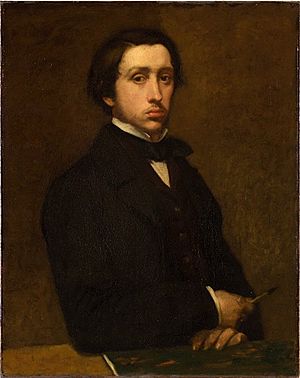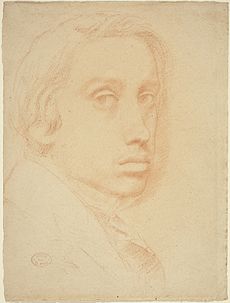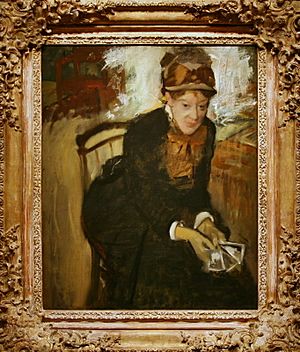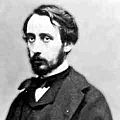Edgar Degas facts for kids
Quick facts for kids
Edgar Degas
|
|
|---|---|

Self-portrait (Degas au porte-fusain), 1855
|
|
| Born |
Hilaire-Germain-Edgar De Gas
19 July 1834 |
| Died | 27 September 1917 (aged 83) |
| Nationality | French |
| Known for | Painting, sculpture, drawing |
|
Notable work
|
The Bellelli Family (1858–1867) Woman with Chrysanthemums (1865) Chanteuse de Café (c. 1878) At the Milliner's (1882) |
| Movement | Impressionism |
| Signature | |
 |
|
Edgar Degas (born July 19, 1834 – died September 27, 1917) was a famous French artist. He is best known for his paintings. He was one of the artists who started a style called Impressionism. However, Degas himself preferred to be called a realist artist. He also made amazing bronze sculptures, prints, and drawings.
Degas is especially famous for painting dancers. More than half of his artworks show dancers. These paintings prove how well he could show movement. His portraits are also special. They show deep feelings and how people can sometimes feel alone.
Contents
Early life of Edgar Degas
Degas was born in Paris, France. His family was quite wealthy. He was the oldest of five children. His mother, Célestine Musson De Gas, was a Creole from New Orleans, Louisiana. His father, Augustin De Gas, was a banker.
When he was 11, Degas started school at the Lycée Louis-le-Grand. His mother died when he was 13. After that, his father and some of his uncles were the main people who guided him. When he grew up, he changed his family name to the simpler "Degas."
Degas started painting when he was young. He finished school in 1853, at age 18. By then, he had turned a room in his house into an art studio. He signed up to copy paintings at the Louvre Museum. But his father wanted him to study law. So, Degas enrolled in law school at the University of Paris in November 1853. However, he did not put much effort into his law studies.
In 1855, he met a famous artist named Jean-Auguste-Dominique Ingres. Degas looked up to Ingres very much. Ingres gave him advice that Degas never forgot: "Draw lines, young man, and still more lines, both from life and from memory, and you will become a good artist." In April of that year, Degas was accepted into the École des Beaux-Arts, a famous art school. He studied drawing there with Louis Lamothe. Under Lamothe's teaching, Degas improved a lot, following Ingres's style.
In July 1856, Degas traveled to Italy. He stayed there for three years. In 1858, he visited his aunt's family in Naples. While there, he studied and copied works by famous painters like Michelangelo and Raphael.
Edgar Degas's art career
In 1859, Degas returned to Paris. He started his first important painting, The Bellelli Family. He also began some paintings about historical myths. In 1861, he visited Normandy. There, he made his first drawings of horses. Horses became an important subject in his later paintings.
When the Franco-Prussian War started in 1870, Degas joined the National Guard. He did not have time to paint during the war. After the war, he went to stay with his brother Rene in New Orleans, Louisiana. In 1873, he came back to Paris. His father died in 1874. Degas then found out that his brother had big business debts. Edgar had to sell the family house and an art collection he had received. From then on, he had to earn money from his paintings. He created many great artworks in the next 10 years. With the money he earned, he bought paintings by artists he admired, such as Manet, Paul Cézanne, Pissarro, Gauguin, and Van Gogh.

In 1874, Edgar Degas and other painters decided to hold their own art shows. These shows were called "Impressionist Exhibitions." In the late 1880s, Degas started taking photographs of his friends. He also took pictures of dancers. These photos helped him create some of his later paintings.
Degas showed only one sculpture during his lifetime. This happened in 1881 when he displayed The Little Dancer of Fourteen Years. It was a wax figure, almost life-size, with real hair and a cloth tutu. Critics had strong reactions to it. Most thought its realism was amazing, but some said the dancer looked ugly.
Degas made many other sculptures over 40 years. But people did not see them until an exhibition in 1918, after he had died.
As he got older, Degas became more isolated. He probably stopped working in 1912. He never married. By the end of his life, he was almost blind. He died in Paris in 1917. Degas left behind more than 2,000 oil paintings and pastels, and 150 sculptures.
Degas's paintings, pastels, drawings, and sculptures are shown in many museums around the world. They have also been featured in many special museum exhibitions.
Edgar Degas and Mary Cassatt
In 1877, Degas invited Mary Cassatt to show her art in the third Impressionist exhibition. He had liked a portrait she showed in 1874. Degas and Cassatt became good friends. They had a lot in common. They both liked similar art and books. Both came from wealthy families. They had both studied painting in Italy. And both were independent and never married.

Cassatt often posed for Degas. She was in his series of paintings about women trying on hats. Cassatt and Degas worked very closely in late 1879 and early 1880. This was when Cassatt was learning more about printmaking. Degas owned a small printing press. Cassatt would work at his studio during the day, using his tools and press. However, in April 1880, Degas suddenly stopped working on a prints journal they were making together. Without his help, the project ended. Even though they continued to visit each other until Degas died in 1917, she never worked with him as closely again.
Images for kids
-
Place de la Concorde, 1875, oil on canvas, Hermitage Museum, St. Petersburg
-
At the Races, 1877–1880, oil on canvas, Musée d'Orsay, Paris
-
Little Dancer of Fourteen Years Cast after his death in 1922 from a sculpture made about 1879–1880. It is made of Bronze with a cotton skirt and satin hair ribbon, on a wooden base. It is at the Metropolitan Museum of Art in New York City.
See also
 In Spanish: Edgar Degas para niños
In Spanish: Edgar Degas para niños












